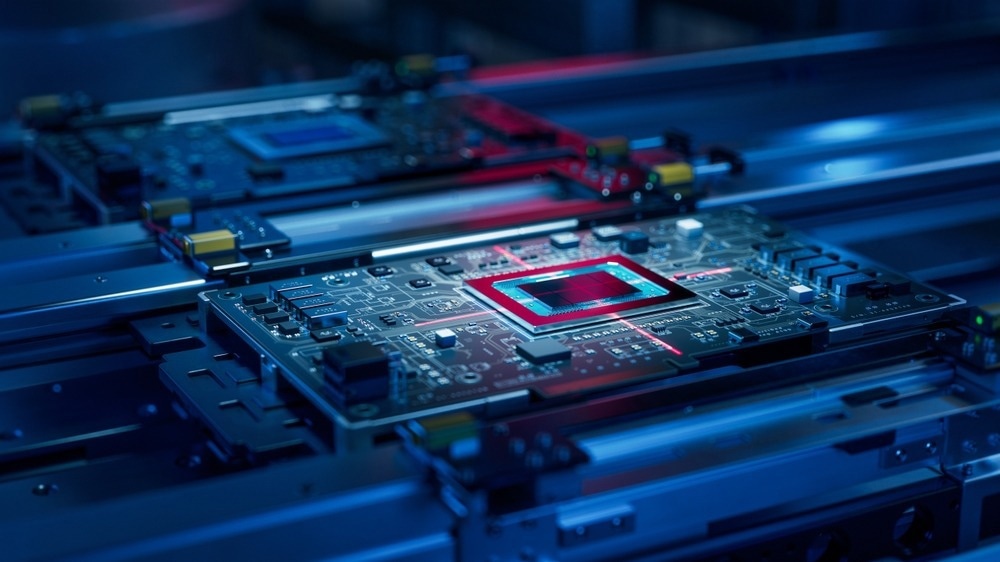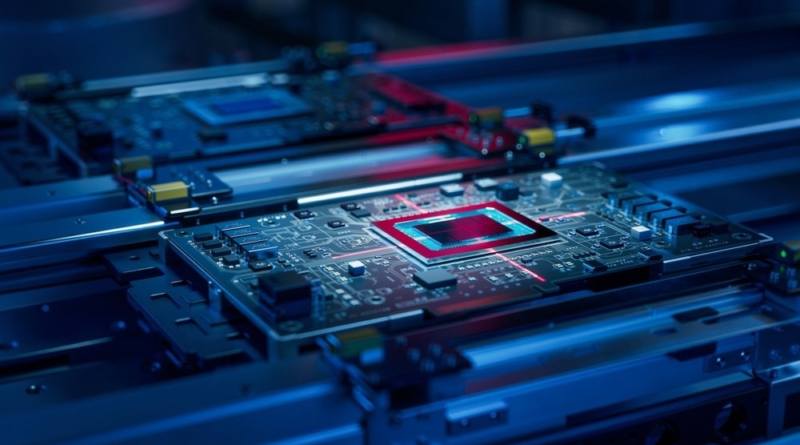Semiconductor Manufacturing: The Industry's Biggest Players – AZoNano
The semiconductor industry has evolved significantly since the late 1950s, expanding globally due to rising demand, technological advancements, and cost-effective production. Countries are now competing to establish themselves as key players in semiconductor manufacturing, recognizing its importance for economic growth, technological leadership, and national security.
Image Credit: IM Imagery/Shutterstock.com
Semiconductors or microchips are the foundational components powering the modern technological landscape. These tiny electronic devices process, store, and transmit data in various electronic devices, from smartphones and computers to advanced medical equipment.
The semiconductor manufacturing industry is a globally interconnected ecosystem, with countries excelling in various supply chain stages.
The United States and Europe lead in the design phase, boasting companies like Qualcomm, Nvidia, and ARM, renowned for their cutting-edge chip architectures and intellectual property (IP).
However, when it comes to fabrication and assembly/testing/packaging (ATP), the spotlight shifts to Asia, where countries like Taiwan, South Korea, China, and Japan dominate the landscape.1
These nations have invested heavily in building state-of-the-art fabrication facilities and developing a robust supply chain ecosystem, making them indispensable players in the global semiconductor industry.
A handful of major global companies dominate the semiconductor manufacturing industry. These industry giants have established themselves as leaders through their technological prowess, extensive research and development efforts, and massive investments in manufacturing facilities.
TSMC is the world's largest pure-play semiconductor foundry, with a market cap of $737.28 billion, specializing in manufacturing advanced chips for various industries.2
It operates multiple fabs globally, exceeding 15 million 12-inch equivalent wafers in annual capacity. With a market share of over 50 %, TSMC is a critical supplier to major tech companies, including Apple, AMD, and Nvidia.1
Samsung is a powerhouse in the semiconductor industry, with a market cap of $376.4 billion.2 Its semiconductor manufacturing division is a core business that manufactures memory chips like DRAM, NAND flash storage, and logic chips.
As one of the pioneers in the semiconductor industry, Intel remains a dominant force in semiconductor manufacturing, with a market cap of $182.77 billion.2
It is renowned for designing and manufacturing powerful, highly efficient, reliable semiconductor chips for personal computers and enterprise servers. The company continues introducing new generations of processors with increased computing power and improved energy savings.1
Other notable players in the semiconductor manufacturing industry include NVIDIA, Qualcomm, and SK Hynix.
While semiconductor manufacturing is a global endeavor, certain countries have emerged as dominant players thanks to their technological infrastructure, supportive government policies, and thriving innovation ecosystems.
Taiwan is the world's undisputed leader in semiconductor manufacturing, primarily due to TSMC's dominance in the foundry business. Taiwan's success in semiconductor manufacturing is attributed to its robust end-to-end semiconductor supply chain, which houses thousands of semiconductor-related companies capable of handling every stage of semiconductor production, from design to fabrication, testing, and packaging.
This comprehensive ecosystem makes Taiwan an attractive destination for companies seeking semiconductor solutions, leveraging the foundry business model.
However, the concentration of semiconductor production in Taiwan also poses risks, as disruptions in manufacturing could have significant global repercussions.3
Semiconductor manufacturing is a major economic industry in South Korea, initially introduced through foreign direct investment by US companies in the mid-1960s. Domestic companies began investing in their production in the 1980s, with Samsung Electronics and SK Hynix emerging as leading semiconductor manufacturers globally.4
South Korea currently leads the production of NAND and DRAM memory chips, essential for managing and storing data on devices like smartphones, PCs, and SD cards.
It plans to establish the world's largest semiconductor cluster in Gyeonggi Province, investing approximately $470 billion over the next 23 years in collaboration with SK Hynix and Samsung.5
Despite facing challenges in recent years, the United States remains a key player in semiconductor manufacturing, thanks to its robust innovation ecosystem, world-class research institutions, and the presence of industry leaders like Intel and NVIDIA.
The US's semiconductor industry heavily influences the global market, particularly through export controls on certain electronic design automation (EDA) software types.
Over the past decades, the US gradually outsourced much of its manufacturing capabilities to Asia. However, recognizing the strategic importance of semiconductor manufacturing, the US government has recently taken steps to revitalize domestic production through initiatives like the CHIPS and Science Act, which aims to incentivize the construction of new fabrication facilities on American soil.6
As one of the world's most technologically advanced countries, Japan is home to more than 100 semiconductor fabrication plants owned by Japanese, American, and Taiwanese firms.
Japanese companies like Tokyo Electron and Nikon are renowned for producing cutting-edge micro-lithography tools and other masking equipment critical in the fabrication process, while firms like Shin-Etsu are critical suppliers of silicon wafers and other raw materials.1
In 2021, Japan's Ministry of Economy, Trade, and Industry (METI) announced a core strategy for its semiconductor and digital industries, focusing on forming partnerships with the US, developing future semiconductor technologies through the establishment of the leading-edge semiconductor technology center (LSTC) and R&D center, encouraging chip manufacturing bases like Japan advanced semiconductor manufacturing (JASM) with TSMC, and providing subsidies for domestic chip production.
This represents a significant shift from past policies towards international collaborations.7
As one of the world's primary manufacturing hubs, China is aggressively expanding its semiconductor manufacturing capacity to achieve self-reliance and reduce dependence on imports. Although China's EDA industry is less technologically advanced, its design capacity is rapidly developing.8
The semiconductor manufacturing capabilities of these nations vary significantly, reflecting their unique strengths and weaknesses within the industry.
Taiwan and South Korea are recognized leaders in the production of advanced logic chips and memory chips, respectively. These countries have invested heavily in cutting-edge manufacturing processes, enabling them to produce the most advanced chips (sub-3 nm) for various applications.
Taiwan produces approximately 50 % of the world's semiconductors, while South Korea hosts a vast network of over 20,000 semiconductor-related companies, with Samsung leading as the largest producer by revenue, holding a 17 % share of the global foundry market.9
Despite possessing only 12 % of the global manufacturing capacity, US semiconductor manufacturing companies hold 40 % of the global IC design market share. This discrepancy is attributed to the dollar value of imported US semiconductors and the operation of US-owned fabrication plants abroad.
The US leads in providing crucial design automation software and core intellectual property (IP) for chip development. US companies also own and operate the largest wafer fabrication plants, primarily handling 12-inch or wider silicon wafers and supplying 44 % of the global wafer fab equipment (WFE). 1
Japan's strength lies in its manufacturing equipment and materials, which are essential for the entire semiconductor supply chain. It is ranked third behind South Korea and Taiwan in the semiconductor manufacturing supply chain, accounting for more than 50 % of the semiconductor material production market and around 30 % of the equipment-production market.7
China has made significant strides in catching up but remains behind the most advanced nodes (sub-5nm), relying on foreign suppliers for its most advanced semiconductor needs.
The semiconductor industry plays a crucial role in the global economy, driving technological advancements and economic growth across multiple sectors. It generates substantial revenue and employment opportunities, with countries possessing strong manufacturing capabilities enjoying positive trade balances and attracting foreign investment.
The global semiconductor chip shortage, exacerbated by COVID-19 and geopolitical tensions, has impacted over 169 countries. It has disrupted manufacturing and supply chains and increased global unemployment, leading to production slowdowns and price increases across the automotive, consumer electronics, and healthcare industries.
With increasing trends such as electric vehicles, IoT, AI-based applications, and cloud computing, demand for semiconductor chips is expected to grow exponentially, potentially leading to a $1 trillion industry by 2030. The automotive, wireless communication, and cloud computation sectors are expected to drive 70 % of this growth.10
More from AZoNano: What is a Graphene Semiconductor?
Disclaimer: The views expressed here are those of the author expressed in their private capacity and do not necessarily represent the views of AZoM.com Limited T/A AZoNetwork the owner and operator of this website. This disclaimer forms part of the Terms and conditions of use of this website.
Written by
NEBOSH certified Mechanical Engineer with 3 years of experience as a technical writer and editor. Owais is interested in occupational health and safety, computer hardware, industrial and mobile robotics. During his academic career, Owais worked on several research projects regarding mobile robots, notably the Autonomous Fire Fighting Mobile Robot. The designed mobile robot could navigate, detect and extinguish fire autonomously. Arduino Uno was used as the microcontroller to control the flame sensors' input and output of the flame extinguisher. Apart from his professional life, Owais is an avid book reader and a huge computer technology enthusiast and likes to keep himself updated regarding developments in the computer industry.
Please use one of the following formats to cite this article in your essay, paper or report:
APA
Ali, Owais. (2024, April 11). Semiconductor Manufacturing By Country: The Industry’s Biggest Players. AZoNano. Retrieved on May 28, 2024 from https://www.azonano.com/article.aspx?ArticleID=6717.
MLA
Ali, Owais. "Semiconductor Manufacturing By Country: The Industry’s Biggest Players". AZoNano. 28 May 2024. <https://www.azonano.com/article.aspx?ArticleID=6717>.
Chicago
Ali, Owais. "Semiconductor Manufacturing By Country: The Industry’s Biggest Players". AZoNano. https://www.azonano.com/article.aspx?ArticleID=6717. (accessed May 28, 2024).
Harvard
Ali, Owais. 2024. Semiconductor Manufacturing By Country: The Industry’s Biggest Players. AZoNano, viewed 28 May 2024, https://www.azonano.com/article.aspx?ArticleID=6717.
Do you have a review, update or anything you would like to add to this article?
Cancel reply to comment
Dr. George Heath
In this interview, AZoNano speaks with Dr. George Heath from the University of Leeds, UK, about the fundamental principles of Atomic Force Microscopy (AFM), integration with advanced optical microscopy, and relevant applications. He also discusses his research utilizing the NanoRacer.
Mariusz Grabowski
In this interview, Mariusz Grabowski, a Design Engineer II at Cadence Design Systems, shares insights into his role, the cutting-edge field of semiconductor technology, and the dynamic intersection of digital design with AI-driven solutions.
David Morris, ICSPI
David Morris of ICSPI highlights the Redux AFM's ease of use, enhancing AFM accessibility for nanoscale imaging.
The Nanospider™ NS 4L1600U is engineered to create nearly defect-free nanofiber membranes suitable for highly demanding applications. It employs the Nanospider™ needle-free technology, ensuring uninterrupted nanofiber jets through the continuous motion of the electrospinning wire.
The Bettersizer 2600 is a robust laser particle size analyzer. With an innovative optical system, it can deliver reliable and accurate particle size measurements. The instrument is easy to operate, cost-effective and very low maintenance.
Haydale’s Functionalized-Graphene Underfloor Heating (FGUH) solutions powered by HDPlas® technology offer enhanced heat transfer properties while reducing energy consumption and simplifying installation processes.
Your AI Powered Scientific Assistant
Hi, I’m Azthena, you can trust me to find commercial scientific answers from AZoNetwork.com.
A few things you need to know before we start. Please read and accept to continue.
Great. Ask your question.
Azthena may occasionally provide inaccurate responses.
Read the full terms.
Terms
While we only use edited and approved content for Azthena answers, it may on occasions provide incorrect responses. Please confirm any data provided with the related suppliers or authors. We do not provide medical advice, if you search for medical information you must always consult a medical professional before acting on any information provided.
Your questions, but not your email details will be shared with OpenAI and retained for 30 days in accordance with their privacy principles.
Please do not ask questions that use sensitive or confidential information.
Read the full Terms & Conditions.
Provide Feedback
AZoNano.com – An AZoNetwork Site
Owned and operated by AZoNetwork, © 2000-2024

